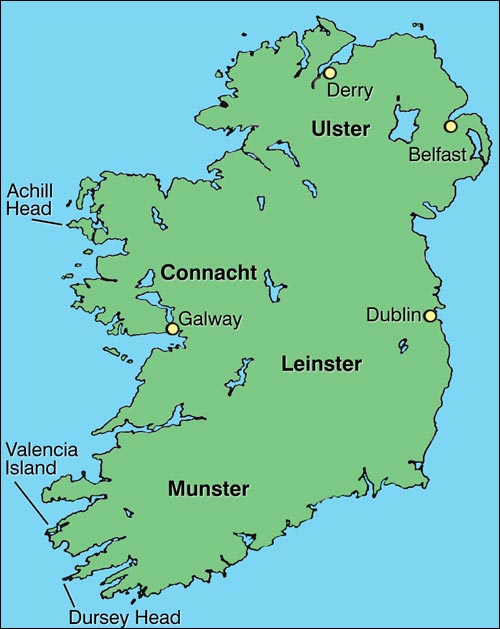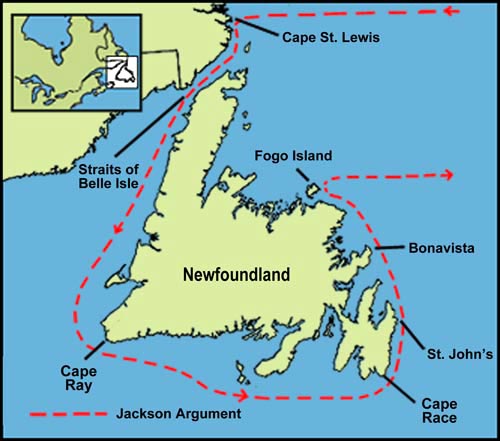Evidence for a Northern Landfall
Cabot's record of the 1497 voyage has disappeared and his crew left no accounts. The only information available comes from non-participants — three letters from two foreign agents in England, Raimondo de Soncino and Lorenzo Pasqualigo, long known, and the John Day letter, discovered in the mid-20th century.
There is very little more. Chronicles, which may not be reliable, record when the voyage began and ended, and later maps may incorporate what Cabot reported. In summary, little is known about the 1497 voyage. As a result it is impossible to say with confidence where Cabot made his landfall. We can only deal with probabilities.
A Voyage in Four Parts
Using the documentary evidence (leaving aside maps), how well can we reconstruct Cabot's voyage, given our knowledge of 15th century navigation methods, and what we believe to have been the effect of wind and weather on a westerly voyage in summer?
The voyage can be divided into four segments: the Atlantic crossing; the landfall; coasting; and the return. This will help us understand why there have been so many different interpretations. It is difficult to separate these segments, and some scholars do not begin their reconstructions from the beginning. Generally, however, all those who have speculated about the voyage try to find fixed points of best evidence, around which other circumstances may be fitted to build a hypothesis.
The Atlantic Crossing
The first divergence of opinion is whether Cabot left Bristol in early or late May – modern scholars, using the Day letter, tend to favour the second alternative (Jackson, 1963). That aside, it is generally agreed that Cabot would have sailed down the Bristol Channel, across to Fastnet, and then north along the Irish coast before turning west. But how far? This is a matter of great importance, since once out of sight of land navigators sailed by latitude. It is often assumed that Cabot's point of departure was Dursey Head (51º31' N), since it was mentioned by John Day, but this is not universally accepted. Harrisse (1892), selected Valencia (51º50' N) on the basis of the number of days taken to cross the Atlantic. Dawson (1897) thought Cabot would have gone as far north as 53º N in order to get as close to Asia as he could, according to the maps at his disposal. For similar reasons, Jackson (1963) argued that Achill Head (54º 04' N) is the most likely place.

A northerly departure is probable, but could Cabot have drifted off course? S. E. Dawson (1897) and Clements Markham (1893) thought that currents and magnetic variations affecting his compass could have pulled him as much as 200 miles south. Modern scholars tend to think that Cabot would have kept more or less on course. He was familiar with the phenomenon of compass variation, kept the North Star on his right, had instruments with which to check latitude, and had ways to measure, if only approximately, how far west he had travelled.
And how far did he travel on the crossing? Pasqualigo reported it was 700 leagues from England to the landfall. Day said it was 1,800 millas from the landfall to Ireland. These distances translate into 1,826 nautical miles and 1,400 nautical miles respectively, and appear to be underestimates. Soncino stated that Cabot had 'passed far beyond the country of the Tanais', meaning Tartary or Cathay, which Jackson interprets to mean more than 1,800 nautical miles.
To distance must be added the time taken. Day said the passage took 35 days. If the first five took Cabot to the Irish coast, 30 are left to cross the Atlantic. Assuming that the Matthew could sail within six points of the wind at five knots, Jackson added seasonally expected winds in nine consecutive zones, and reckoned that Cabot could have crossed the Atlantic from Ireland in just under 24 days, nearly 36 days in all. The currents would have reduced his latitude from about 54º N to 53º N or 52º N.
Landfall
This brings Cabot to the south coast of Labrador, in the area of Cape St. Lewis (52º22 N). If Cabot had checked his observations, he would have found that he was approximately in the latitude of Dursey Head, 1,800 millas to the east. Archaeologist Peter Pope also supports the theory of a northern landfall, which he places somewhere between Sandwich Bay, Labrador, and White Bay, Newfoundland (Many Landfalls 29).

The landfall occurred on 24 June, and Cabot was back in Bristol on 6 August, after a 15 day crossing from the easternmost cape 'of the mainland' he had discovered. He therefore explored the region for about a month. Pasqualigo said Cabot coasted 700 leagues, and Day stated that he sailed as far south as the parallel of the Bordeaux river, approximately 45º35' N.
The literary evidence describing the landfall again comes from Pasqualigo, Soncino, and Day. Taken together it appears that Cabot and his men went ashore, the first Europeans since the Norse (Englishmen led by an Italian) to set foot in North America. They put up a cross and planted beside it the banners of England and Venice, thus claiming the country for the king of England. They met no inhabitants, but saw signs of human life. Cabot thought he had reached the northeastern extremity of Asia and, like Columbus, thought the populous cities with roofs of gold, and the sources of silk and spices, could not be too far off.
Jackson argues that from Labrador, Cabot sailed south and west, since that was the direction in which he thought Cathay was located. He entered the Straits of Belle Isle, and choosing the eastern shore because it looked like mainland, reached Cape Ray. Here the land swung abruptly to the east, and Cabot realised that he had found an island which, because it was not large enough to be Cipango, had to be the Island of the Seven Cities, mentioned by most sources. At Cape Race he sailed north to regain latitude near to that he had taken from Ireland, turning east near Fogo and reaching Brittany before returning to Bristol.
Jackson's reconstruction of the 1497 voyage is one of many, and does not rely on cartographic evidence. Moreover, Jackson was neither a Canadian nor a Newfoundlander a factor which should not be discounted, since in controversial matters like the Cabot landfall, patriotism has had a definite impact on interpretation.




